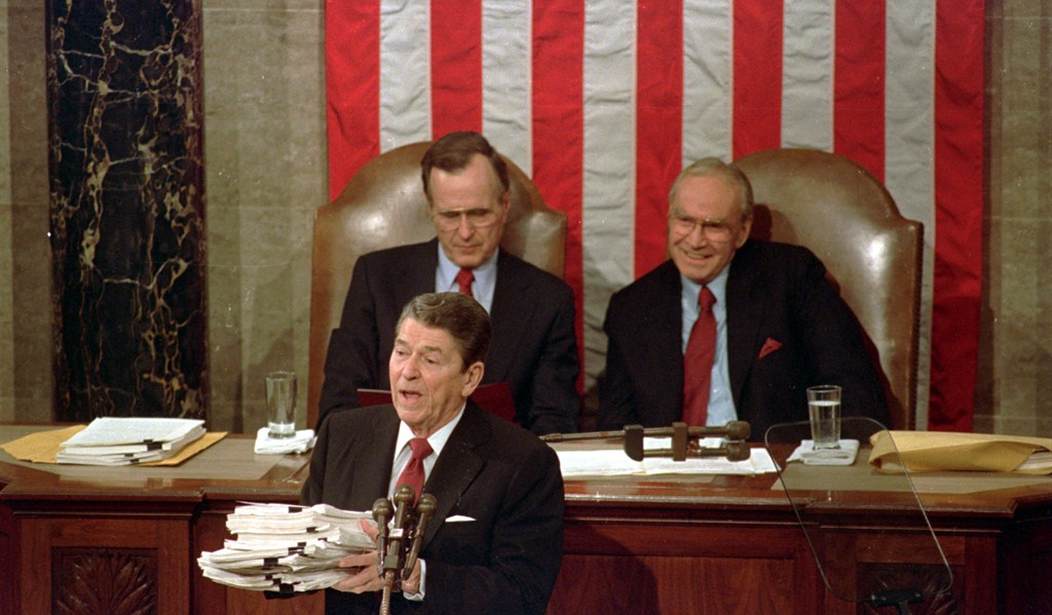Editor’s note: This article first appeared at TheBlaze.com.
A rudderless Republican Party, afraid to assert itself in the face of a rising liberal/progressive onslaught. A confident Democratic Party in the White House, undermining the nation, its economy, and its foreign policy, with timid Republicans feckless in response. A battle for the heart of the GOP and the next presidential nomination among conservative Republicans and liberal Republicans.
Sound familiar? Of course. But I’m not just talking about March 2014. I’m also talking about March 1977, when a genuine conservative Republican named Ronald Reagan surveyed the political landscape and saw something hauntingly similar. Reagan resolved to do something about it, and he laid out that vision 37 years ago, at CPAC, the annual Conservative Political Action Conference. What Reagan said in that speech remains crucial for conservatives and the Republican Party today.
Ronald Reagan began speaking at CPAC in 1974, its first gathering. He addressed the faithful 13 times through his final year in the White House. But perhaps his most vigorous defense of conservative thinking came in his remarks delivered on February 6, 1977, his 66th birthday.
Reagan began by explaining his view of conservatism: “The common sense and common decency of ordinary men and women, working out their own lives in their own way—this is the heart of American conservatism today. Conservative wisdom and principles are derived from willingness to learn, not just from what is going on now, but from what has happened before.”
Conservatism rests on time-tested principles worth conserving and preserving for the best of the country, its culture, its people. Said Reagan: “The principles of conservatism are sound because they are based on what men and women have discovered through experience in not just one generation or a dozen, but in all the combined experience of mankind. When we conservatives say that we know something about political affairs, and that we know can be stated as principles, we are saying that the principles we hold dear are those that have been found, through experience, to be ultimately beneficial for individuals, for families, for communities and for nations—found through the often bitter testing of pain or sacrifice and sorrow.”
Recommended
Reagan told the CPAC brethren that he believed the “old lines” dividing social and economic conservatives were “disappearing.” He hoped the time had come “to present a program of action based on political principle that can attract those interested in the so-called ‘social’ issues and those interested in ‘economic’ issues.”
Reagan insisted that a “conservative majority” could emerge from within the fractured Republican Party to win back the White House and America. This would require, he said, an adherence to “political principle” and to “principled politics.”
What sort of principles? In my new book on Reagan conservatism, I lay out 11 clearly identifiable principles of Reagan conservatism:
- Freedom
- Faith
- Family
- Sanctity and dignity of human life
- American exceptionalism
- The Founders’ wisdom and vision
- Lower taxes
- Limited government
- Peace through strength
- Anti-communism
- Belief in the individual
Those principles worked for Reagan, and there’s no reason to suspect they wouldn’t work again. They are timeless and time-tested. They are not only a prescription for a conservative platform, but they draw a perfect contrast to progressivism.
Reagan proceeded to unflinchingly hold to these principles. How successful was that plan? In 1980, pursuing a bold, unapologetic conservative agenda, Reagan won 44 of 50 states against an incumbent president. Four years later, he won 49 of 50 states. He won those two elections by a combined Electoral College margin of 1014 to 62. He twice won states like California and Massachusetts, Pennsylvania and New Jersey. And when he was finished, liberalism was dead for a generation.
Now liberalism is back, in the form of what it’s calling “progressivism.” It can be defeated again.
As Reagan often said, freedom is always a generation away from extinction. Each new generation needs to fight for it again. The fight can be painful, but it needs to be fought nonetheless. It’s every generation’s duty.
This should have special resonance for conservative Republicans who, like Ronald Reagan, want to take their party in a conservative direction as they endeavor to recapture the White House and re-change the nation. In his ongoing messages to his fellow conservatives at CPAC, Reagan essentially told them to be not afraid—that is, to be not afraid of conservatism, to not fear who and what they are. “The time has come,” he confidently told them in February 1977.
What kind of time? Only Ronald Reagan the optimist could have been so optimistic. The Republican Party was in a shambles after Watergate, the withdrawal from Vietnam, the uninspiring Ford presidency, Rockefeller Republicanism, détente and accommodation of the Soviets, the Democratic leadership in the White House, a malaise and misery index, unemployment and gas lines, and more. Two terms of Republican control of the White House had merely opened the door for Jimmy Carter, who, as Reagan spoke, had been sworn in just two weeks earlier.
And so, what time had come?
Reagan a decade earlier called it a “Time for Choosing.” A time, he dramatically said, to preserve for America’s children “this, the last best hope of man on earth.” “If we lose freedom here,” said Reagan, “there’s no place to escape to.” Choosing wrong meant a long period of “darkness.” Reagan believed that conservatism shined a light through the darkness.
“We can do it,” Reagan insisted. “This is not a dream, a wistful hope…. I have seen the conservative future and it works.”
It would be easy to dismiss this as pie-in-the-sky in 2014, just as it seemed in 1977. But Ronald Reagan made it work. He turned the tide. Why can’t it happen again?

























Join the conversation as a VIP Member